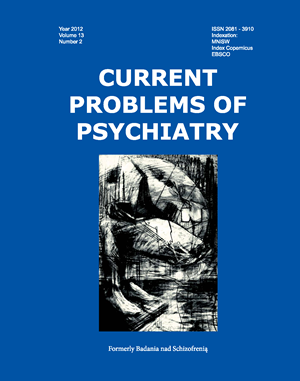Zespół stresu pourazowego – rys historyczny, terminologia, metody pomiaru
Słowa kluczowe:
zespół stresu pourazowego, rys historyczny, kryteria diagnostyczneAbstrakt
Posttraumatic stress disorder – PTSD is an anxiety disorder occurring in people exposed to a traumatic event. Disorder symptoms must occur after the traumatic event, cannot overtake it.
The picture of PTSD depends on many pretraumatic factors, the type of acting factors and the circumstances of the exposure such as support and expert assistance.
Although the concept of PTSD diagnostic category was introduced in the 1980s, this disorder accompanied humanity since its beginnings, because for centuries humanity met traumatic events that caused fear and anxiety. There were wars, traffic accidents or natural disasters. This has been described in the literature, as well as in medical observations. Over the years, the understanding and perception of PTSD has changed. That was the reason for evolution of definition and the idea of PTSD. Those changes were reflected in the commonly used diagnostic classifications of the ICD or DSM.
This process has been accompanied by the development of measurement tools used for diagnosis and for further research. The variety of methods developed so far, interviews and self-assessment questionnaires, allow for more objective and accurate diagnosis of the disorder.
Some of the tools such as the Mississippi Scale for Combat-Related PTSD are intended to diagnose veterans and have Polish validation, which allows to exam civilians while others are designed to test children (Children's PTSD Inventory).
Bibliografia
1. Stępień M. Ensi w czasach III dynastii z Ur: aspekty ekonomiczne i administracyjne pozycji namiestnika w świetle archiwum z Ummy. Warszawa; UWaL: 2006.
2. Ben-Ezra M. Trauma 4000 Years Ago?. Am J Psychiatry, 2002; 159: 1437-1437.
3. Shay J. Learning about combat stress from Homer's Iliad. J Trauma Stress, 1991; 4: 561-582.
4. Shay J. Odysseus in America: Combat Trauma and the Trials of Homecoming. New York; Sribner: 2002.
5. Dudek B. Zaburzenia Po Stresie Traumatycznym. Gdańsk; Gdańskie Wydawnictwo Psychologiczne: 2003.
6. Heitzman J. Psychiatryczna diagnoza zespołów pourazowych – klinika, orzecznictwo. Psychiatria w Praktyce Ogólnolekarskiej; Via Medica, 2002; 1 2.
7. Black D. Psychological trauma: a developmental approach. London; Gaskell: 1997.
8. Hovens J.E. Research into the psychodiagnostics of posttraumatic stress disorder. J Trauma Stress., 1996; 9(2): 399-400.
9. Friedman M.J., Terence M., Resick P.A. Handbook of PTSD: Science and Practice. New York; Guilford Pubn: 2010.
10. Erichsen J.E. On Railway and Other Injuries of the Nervous System. Philadelphia; Henry C. Lea 1867.
11. Van der Kolk B.A., Brown P., Hart O.P. Janet on post-traumatic stress. J Trauma Stress, (2-4) 1989; 365-378.
12. Wilson J.P. The Historical Evolution of PTSD Diagnostic Criteria: From Freud to DSM-IV. J Trauma Stress, 7,(4), 1994.
13. Orwid M. Krakowskie badania nad PTSD. Dialog.11, Mit i tabu, 2002.
14. Heitzman J. Psychiatryczna diagnoza zespołów pourazowych – klinika, orzecznictwo. Psychiatria w Praktyce Ogólnolekarskiej. 2002; 2:21-38.
15. Heitzman J. Reakcja na ciężki stres i zaburzenia adaptacyjne W., Pużyński S., Rybakowski J.,Wciórka J. Psychiatria, T. 2, Wrocław;Urban & Partner: 2011; 428-452.
16. International Classification of Diseases, Revision 6 http://www.wolfbane.com/icd/icd6h.htm. 1.03.2012
17. International Classification of Diseases, Revision 8 http://www.wolfbane.com/icd/icd8h.htm. 1.03.2012
18. ICD-10.Klasyfikacja zaburzeń psychicznych i zaburzeń zachowania w ICD 10. Badawcze kryteria diagnostyczne. Kraków-Warszawa; Vesalius Instytut Psychiatrii i Neurologii: 1998.
19. American Psychiatic Association .Diagnostic and statistical manual of mental disorders.Txt Revision.4th ed.Washington 2000.
20. Diagnostic and Statistical Manual of Mental Disorders (DSM-5) http://www.dsm5.org/ProposedRevision. 1.03.2012
21. Rosen G.M., Lilienfeld S.O., Frueh B.C., McHugh P.R., Spitzer R.L. Reflections on PTSD’s future in DSM-V. The British Journal of Psychiatry, 2010; 197: 343-344.
22. Hovens J.E. Research into the Psychodiagnosics of Postttraumatic Sress Disorder. Delft; Eburon Press: 1994.
23. Newman E., Kaloupek D., Keane T. Assessment of posttraumatic stress disorder in clinical and research settings.van der Kolk B.A., McFarlane A C., Weisaeth L. W: Traumatic stress: The effects of overwhelming experience on mind, body, and society. New York; Guilford Press:1996: 242-275.
24. Robins L.N., Helzer J.E., Croughan J.L., Ratcliff K.S., National Institute of Mental Health Diagnostic Interview Schedule: its history, characteristics and validity. Arch Gen Psychiatry, 1981; 38(4): 381-389.
25. First M.B., SpitzerR.L., Gibbon M., Williams J.B.W. The Structured Clinical Interview for DSM-III-R Personality Disorders (SCID-II). Part I: Description. J Personal Disord., 1995;(9),(2): 83-91.
26. Davidson, J.R.T., Kudler H.S., Smith R.D. Assessment and pharmacotherapy of posttraumatic stress disorder. W: Giller J.E.L. Biological assessment and treatment of posttraumatic stress disorder. Washington DC; American Psychiatric Press: 1990: 205-221.
27. Watson C.G., Juba M.P., Manifold V., Kucala T., Anderson P.E. The PTSD interview: rationale, description, reliability, and concurrent validity of a DSM-III-based technique. J Clin Psychol., 1991; 47(2): 179-88.
28. Brown, T. A., Di Nardo, P. A., Barlow, D. H. Anxiety Disorders Interview Schedule for DSM-IV (ADIS-IV). San Antonio; Psychological Corporation/Graywind Publications Incorporated: 1994.
29. Saigh P.A., Yasik A.E., Oberfield R.A., Green B.L., Halamandaris P.V., Rybenstein H. The Children’s PTSD Inventory: Development and reliability. J Trauma Stress, 2000; 13: 369-380.
30. Saigh P.A. The development and validation of the children’s post traumatic stress disorder inventory. International Journal of Special Education, 1989; 4: 75-84.
31. Horowitz M., Wilner M., Alvarez W. Impact of Event Scale: A measure of subjective stress. Psychosom Med., 1979; 41: 209-218.
32. Juczyński Z., Ogińska-Bulik N. Pomiar zaburzeń po stresie traumatycznym — polska wersja Zrewidowanej Skali Wpływu Zdarzeń. Psychiatria., 2009; 6 (1):1-8
33. Keane, T. M., Caddell, J. M., Taylor, K. L. Mississippi Scale for Combat-Related Posttraumatic Stress Disorder: three studies in reliability and validity. J Consult Clin Psychol., 1988; 56: 85-90.
34. Lis-Turlejska M., Łuszczyńska-Cieślak A. Adaptacja cywilnej wersji Kwestionariusza Zespołu Stresu Pourazowego: Mississippi PTSD Scale. Czas. Psychol., 2002; 7: 165-173.
35. Carlier I.V.E., Lamberts R., Van Uchelen A.J., Gersons B.P.R. Disaster – related post-traumatic stress in police officers: A field study of the impact of debriefing. Stress Medicine, 2008; 14: 143-148.
36. Koniarek J., Dudek B., Szymczak B. Kwestionariusz do pomiaru zespołu zaburzeń po stresie urazowym (K-PTSD) – zastosowanie PTSD interview Ch. Watson i in. w badaniach grupowych. Przegl. Psychol., 2000; 43:205-216.


